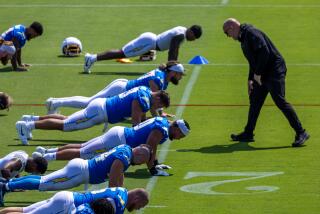St. Louis Rams’ relocation bid contends they have the best plan for L.A. and NFL
REPORTING FROM NEW YORK — The Inglewood stadium proposal backed by the St. Louis Rams is vastly superior to the rival plan in Carson and could be a financial windfall for the NFL, the franchise argued in its relocation application submitted to the league Monday.
The 29-page document obtained Tuesday by The Times lays out the team’s rationale for why it should be able to leave St. Louis and how it believes such a move would ultimately strengthen the NFL.
“The Rams’ Inglewood project presents the league and all of the member clubs with the best opportunity for successful long-term operations in Los Angeles,” the application said.
Which team would you like to see come back to L.A.? Weigh in on our Facebook page >>
The San Diego Chargers and Oakland Raiders also applied to relocate as well, touting their joint project in Carson that’s projected to open in 2019 and detailing the reasons why they believe they should be allowed to leave their current markets.
League owners will gather for a special meeting in Houston next week in hopes of resolving the L.A. quandary.
The NFL’s stadium, finance and L.A. committees meet Wednesday and Thursday of this week at league headquarters in New York to discuss the situation.
Although the developers at the Inglewood site have long said their stadium would be ready for the 2018 season, the Rams’ application targets 2019 as the proposed start date. There was no elaboration on the change for the $1.86-billion project that the Rams describe as “shovel ready.”
The document provides a rare look into a landmark moment in the NFL’s two-decade quest to return to L.A.; this is the first time teams have formally asked to relocate to the country’s second-largest market.
The application is divided into three parts: discussing the strengths of the Inglewood plan, explaining why the Rams have a right to move after two decades in St. Louis, and outlining how the league will benefit from the team’s relocation.
The application provided the most detailed look at the stadium, which would be the NFL’s largest, since the project’s unveiling a year ago. The venue would be capable of hosting two teams with 70,240 fixed seats and accommodate another 30,000 people in standing-room-only areas for large events. There would be 274 suites, 16,300 premium seats and 12,675 dedicated surface parking spaces -— all numbers the Rams say exceed those in the Carson proposal.
“We believe an Inglewood Super Bowl could generate as much as $50 million more in league revenue than the Carson proposed stadium based on increases in seat capacity, premium seating and total number of suites,” the application said.
The Rams envision the stadium forming the hub of NFL activity on the West Coast. It includes the stadium — which would be nearly 3 million square feet — hosting the combine and Pro Bowl. The neighboring performance venue could be home to the NFL draft, NFL Honors and other league-themed events such as NFL Films premieres. Some of the office space in the planned mixed-use development around the stadium could accommodate the NFL Network, NFL Media and NFL Digital, allowing them “dynamic new space just three miles from their current Culver City location.”
The Rams argue that they have the strongest L.A. fan base of the three teams seeking to relocate.
“Polling throughout the relocation process has consistently shown the Rams as a single team have more fan support than the Chargers and Raiders combined,” the application said.
The document cites a marketing focus group the NFL held in L.A. in August in which “30 out of 53 respondents preferred the Rams to relocate, followed by 17 votes for the Chargers and six for the Raiders.”
The same focus group sessions showed that more than 90% of the attendees preferred the Inglewood site, the Rams said.
The application sounds more like a legal document when it veers into discussion about the Rams’ lease at the Edward Jones Dome in St. Louis and why the team thinks it is free to move.
“Twelve years of fruitless talks culminating in an intense one-year exchange of proposals in an agreed-upon process that cost the parties more than $7 million meets any standard of good-faith community engagement,” the application said.
Some of the strongest language is reserved for the $1.1-billion riverfront stadium deal being proposed by St. Louis, in which the Rams would be responsible for all stadium operations and maintenance costs for the stadium’s first 30 years. The Rams say that would increase their current rent by a factor of 20.
See the most-read stories in Sports this hour >>
A spokesman for the St. Louis stadium task force said the Rams’ assessment of their experience in the city “is inaccurate and extremely disappointing.”
“We have a spectacular stadium proposal that delivers the certainty the NFL has asked for, and we are and will continue to be an excellent home for the St. Louis Rams,” said Jim Woodcock.
The St. Louis plan calls for the league and the Rams to kick in at least $710 million toward the project, with $355 million in public contributions. That’s short of the $400 million the St. Louis stadium task force promised league owners two months ago, the Rams said.
The Rams’ application argues that even “the most cursory analysis of the St. Louis financial proposal makes no economic sense for an NFL team.”
A heading in bold emphasizes the point: “No NFL Club Would Be Interested In The … New St. Louis Stadium.”
Follow Sam Farmer on Twitter @LATimesFarmer
Follow Nathan Fenno on Twitter @nathanfenno
MORE SPORTS NEWS
Scott Kazmir has opt-out clause but ‘would be honored’ to end career with Dodgers
Mike Piazza’s desire to enter Hall of Fame in a Mets cap speaks volumes
Pac-12 football’s performance in the bowl spotlight was, well, spotty
More to Read
Go beyond the scoreboard
Get the latest on L.A.'s teams in the daily Sports Report newsletter.
You may occasionally receive promotional content from the Los Angeles Times.












